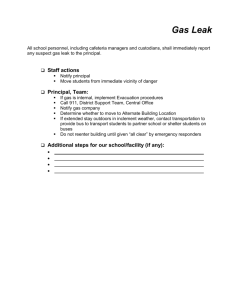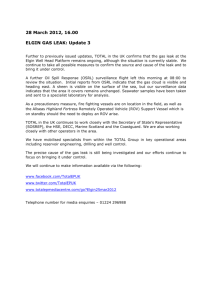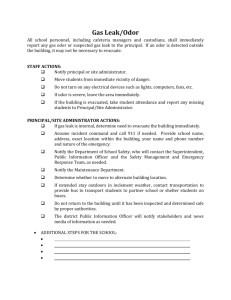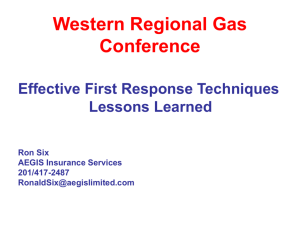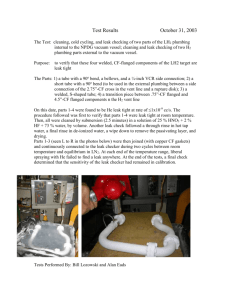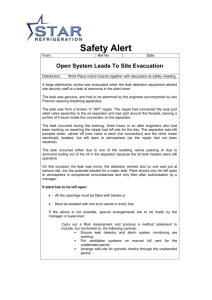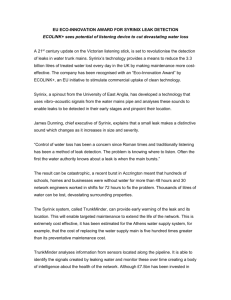Focus/Actions of the Gas Company First Responder
advertisement
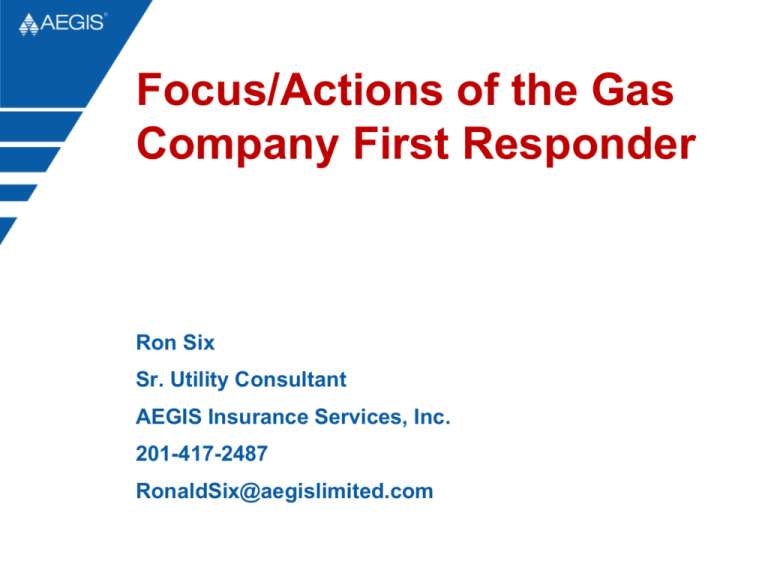
Focus/Actions of the Gas Company First Responder Ron Six Sr. Utility Consultant AEGIS Insurance Services, Inc. 201-417-2487 RonaldSix@aegislimited.com A AE E GG II S S ssociated lectric as nsurance ervices AEGIS Background Information • Utility Mutual Insurance Company (member owned) • Formed in 1975 by 22 gas utilities • Electric Utilities began joining in 1977 • 375 members – 95% utilities and related energy AEGIS Loss Control Division • Mission To assist AEGIS Member companies maintain effective and safe operating systems while reducing their overall long-term cost of risk, by developing and providing products, services and training specifically for this purpose. AEGIS Loss Control Division • Products/ Services: – Risk Assessments – Self-Administered Risk Assessment Guides – Occupational Safety & Workers’ Compensation Program Assessment – Training - Gas Operator * First Response * Investigation of Gas Related Incidents * Leakage Program Management * Gas Leak Pinpointing * Customer Contact * Utility Locating AEGIS Loss Control Division – Lessons Learned Video Series * Too Little…. Too Late * Pressure Point * The Smell of Danger * A Toxic Tale * Hidden Danger * First Line of Defense * Recognizing and Avoiding the Hazards (Volume I & II) * Emergency Exercises “A Look in the Mirror” * People Don’t Know What They Don’t Know * Public Safety – Communication and Emergency Response * The Find and Fix Syndrome * Anatomy of a Gas Leak (A Collaborative Approach) AEGIS Loss Control Division – – – – – – – – – First Responder Emergency Response Tip Cards Hazardous Conditions (Red Tag) Procedure Employee Public Safety Awareness Program Review of Major Liability Losses (RMLL) Lessons Learned Webinars (3-4 year) Media Relations at Incident Scene Investigating Natural Gas Incident Workshop (6 year) Investigating Electrical Incident Workshop (4 year) Emergency Preparedness and Response Seminar October 15-17, 2013 Indianapolis, IN www.aegislink.com Our main job is not finding & fixing leaks Our main job is public safety Where Things Go Wrong • Complacency – “We’ve done this job dozens of times” • Tunnel Vision – Not focusing on the overall picture • Shortcuts – Not following the approved procedures • Lack of training/inexperience – Have never experienced this situation The above highlight the importance of using Mock Emergency Drills and Emergency Response pre-planning The Athens, Ohio Incident • Don’t become complacent • Don’t “ASSUME” anything • Don’t take natural gas for granted • Don’t catch the “Find & Fix Syndrome” • Follow procedures Remember your main job is “Public Safety” and you are also part of the Public. Recent Natural Gas Incidents Springfield, MA Indianapolis, IN The Combustible Gas Indicator • CGI should be used to: – Classify an atmosphere • Inside a building or in a confined space – Classify underground leakage • Determine “Where is the gas?” – Pinpoint underground leakage • Determine “Where is the leak?” • You must know: • How to properly use it • What readings might constitute a hazardous condition 1% Gas In Air Gas Meter • In the last 20 years, over 32% of natural gas-related incidents/explosions have been a direct result of “dig-ins” or outside damage! • This is the major reason why we should always promote the “Call Before You Dig Program.” Figure # 1 Gas Meter #6 ASH STREET Sewer Ditch 4” Steel Main 45 PSI Incident (1998) Company Retention $5M • A contractor working on a highway reconstruction project struck the service line to a house, causing the service line to separate from a compression coupling near the gas main. • The gas company was called at 11:15 am; a serviceman arrived on the scene at 11:45 and immediately called for a crew. Thinking the gas was venting out into the street, he sat in his truck for 20 minutes until the crew arrived. Although the damage location was only 32 feet from the incident site, no attempt was made to check nearby buildings with a combustible gas indicator for the presence of migrating gas. Incident (1998) Company Retention $5M Cont’d. • The leaking gas migrated to the house where an explosion occurred killing an elderly woman and severely burning 3 children, the explosion occurred at 1:00 pm. The children received burns to over 45% of their bodies with most of the burns occurring in the facial areas. • In the settlement the contractor also paid more than $15,000,000.00 in claims. AEGIS Incurred $15 Million What Happened? • First Responder failed to recognize the gravity of the situation and made the assumption that the pulled line was leaking in only one place. The First Responder’s main job on a reported gas leak is to determine “Where is the gas?” and “Is it affecting people or property?” The appropriate way of determining this is with a combustible gas indicator (CGI) – Test Don’t Guess! • Our first priority must always be focused on Public Safety The “Find and Fix Syndrome” The cure for this is to ask yourself a question “Where is the gas”? If you can answer the question that the gas is not affecting people and it is not affecting property you are cured. You must ask yourself this question on every leak before you get into the “repair” mode. “Dig-Ins”/3rd Party Damage First Responder should monitor the area and surrounding buildings while the crew works at repairing the leak. Factors Affecting Gas Migration • Soil type • Soil moisture • Surface cover/frost • Line pressure • Depth of burial • Leak size and age • Change in elevation=slope • Path of least resistance Remember: • The biggest built-in safety factor of natural gas is that it is lighter than air; however… it will vent to the atmosphere someplace! Evaluating The Leak Where is the gas? gas? r w h e e is the Evaluating The Leak • • • • • W here is the gas? How much is there? Extent of hazard (migration) Relation to other structures Evaluate/evacuate “Centering” = Where is the Gas? Centering The Leak • Probe holes must be of sufficient depth • Test all available openings • “Zero out” N-S-E-W • You must have sufficient information to make a good judgement Be Careful – “Don’t make a leak, looking for a leak.” The Four Dimensions of Gas Leak Classification 1. Dispersion =Determine the perimeter of the leakage area by bar testing. 2. Location = 3. Magnitude = CGI readings. 4. Evaluation = Operator using guidelines and his or her judgment weighing the above 3 factors. Leakage area as compared to the surrounding environment. GPTC Guidelines Grade 1 Definition • A leak that represents an existing or probable hazard to persons or property, and requires immediate repair or continuous action until the conditions are no longer hazardous. • Odor complaint investigations …begin with a call • An odor complaint call should be considered a Grade 1 leak… until proven otherwise. The Key Is Listening • Not every call is a gas emergency, however, calls involving an odor complaint should be considered an emergency. • Listen to the customer and ask questions in order to gather the information needed The Call Center is the First Line of Defense Customer Call Scenario #1 8:15 a.m. I got up this morning and thought I smelled gas. I am running late for work and wonder if you could have someone stop by to check it at 4:30 when I get off work? How would you respond? Customer Call Scenario #3 10:30 a.m. I was digging to install a sewer line in the road here on Route 6 and I just hit one of your gas lines. It is leaking pretty good, could you send someone over to fix it? I shut off my backhoe after I hit the line. Is it OK if I start it up and move it? How would you respond? Customer Call Scenario #4 4:30 PM Me alegro de que usted habla Espnol porque no hablo Ingles. Creo que tengo una fuga de gas porque huelo un olor extraño. Yo vivo en el 1500 Spring Street en Tempe, AZ. ¿Podría usted enviar ha alguien que lo pueda comprobar. Translation I'm glad that you speak Spanish because I don't speak English.I think I have a gas leak because I smell a strange odor. I live at 1500 Spring Street in Tempe, AZ. Could you send someone over to check it for me. How would you respond? BRADY ST. #894 #8 #902 2” Steel Gas Main 45 psi Excavation Sewer Manhole SLOCUM ROAD Steps to Consider When Receiving a Dynamic Call • Ask the customer to leave the premises until help arrives • Advise the customer to leave the phone off the hook and not to operate any lights or turn any appliances off or on Leave things as they are… leave the premises immediately Conducting The Investigation Do Not Assume Anything! Test, Don’t Guess Approaching The Building • Visual observations – Vegetation damage – Construction activities – Meter observations • Olfactory senses – Do you smell anything? Entering The Building • CGI zeroed before entering • Enter on LEL scale • Check the problem area • Continue search even if leak is found • Did you find “a” leak or did you find “the” leak? Expanding The Search • Check the entire gas system • Visual inspection of appliances and piping • Check all utility entrances and floor drains Other Conditions To Observe • Carbon monoxide • Other flammables • Lack of make up air, vent size • Scalding • Other code violations Action When A Hazardous Condition Is Found • Red or “Danger” Tag – – – – Document Communicate Disconnect Follow up Policies may vary from company to company Completing The Investigation • Shut in test/clock meter • Test meter/leak detection fluid • Bar test – At the meter (riser), service, along main and check all available openings • Expand search if odor detected • Document findings Leaks Found On Odor Complaints Must Be: • Repaired • Shut off & tagged • Classified (is it safe?) There should be no other options! Repeat Calls • Use different equipment • Send different personnel • Send supervisor to verify • Track time/conditions • Is it natural gas? (verify odor) Remember, you must respond Makesafe Actions to Consider • Implement emergency plan • Call for additional help • Notify police/fire departments • Evacuate premises Time Is Critical • Block off the area • Stop the flow of gas • Eliminate ignition sources • Vent area Remember Public Safety! Our main job is not finding & fixing leaks Our main job is public safety Never Let Your Guard Down Be Alert Be Prepared Be Safe AEGIS Insurance Services, Inc. Thank You Please visit our website @ www.aegislink.com
